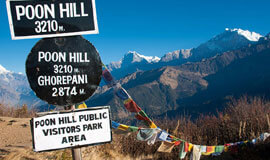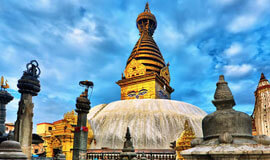
Experiencing Adventures Nepal
Explore Nepal with jungle walks and safaris at Chitwan, boating on Phewa Lake, and trekking through villages. Experience sunrise views from Poon Hill on your adventure tour of Nepal.

A trek is an ideal way to see the country and to understand its people. To experience walking through emerald rice fields; through towering rhododendron forests; crossing streams, camping out on a hilltop in the wilderness surrounded by the world's highest peaks is why many people come to Nepal. The two most popular treks are to the Everest Base Camp and the around the foothills of the Annapurna range. There is more to Nepal than treks however. Adrenaline sports fans will love the white water rafting excursions through deep gorges, bungee- jumping off cliffs, hot-air ballooning above the glaciers and mountain biking along rugged trails.
Nepal also has amazing wildlife, seen up close on safari at places like Royal Chitwan National Park, where you can travel by elephant to see wild rhinoceros and tigers in their habitat. Nepalese art and architecture is captivating, attracting visitors to places like the medieval town of Bhakhtapur, with its intricately carved wooden houses, or to the dramatic Baudhanath Temple, with its massive white dome and thousands of brightly coloured prayer flags fluttering in the breeze as saffron robed monks chant within. Nepal has 7 Unesco World Heritage Sites and 8 of the world's tallest mountains including the famed Mount Everest. You can get a bird's eye view by taking the spectacular morning mountain flight over the Himalayas from the capital Kathmandu.
Kathmandu is a shoppers' delight, with its dazzling handicrafts such as exquisite wood carvings, prayer wheels, stone carvings, singing bowls, thangkas and pauvas, pashminas and distinctive silver jewellery. Whether you're looking for adventure or a relaxed mountain retreat, Nepal is a fascinating country, home of the Ghurkas, the Sherpas, the birthplace of Buddha, and the conquering of Everest.
Know before you go
Nepal is generally dry except during the Monsoon season from the end of June to the middle of September. About 80% of Nepal's annual rainfall is during that period. Spring and autumn are the most pleasant seasons; winter temperatures drop to freezing, with a high level of snowfall in
ATMs are widely available in Nepal, however, it is not possible to withdraw cash in the high mountains so trekkers should take enough cash for the duration of their trek.
Nepalese Rupee (NPR)
Drugs are a growing problem in Nepal and the authorities are determined to tackle and control the problem. Penalties for drugs related offences are severe. Possession of small amounts of marijuana can lead to a prison sentence in excess of five years, usually after a lengthy and expensive legal process.. Never become involved with illegal drugs of any kind in Nepal.
The most common health problem is mild diarrhoea and stomach upsets which can be minimised by taking precautions such as drinking only bottled or purified water, and avoiding unwashed fruits and raw salads. Bring Imodium or similar medicine for relief. Meats should be well cooked. Malaria precautions should be taken if you are travelling in a malarial area. Using a sunscreen with a high SPF and keeping hydrated can easily prevent sunburn and dehydration. All Xperiencing India tours supply plenty of bottled water as standard. With regard to vaccinations check with your health care professional.
You should respect local customs. Women should avoid wearing shorts and sleeveless tops in public places where this might be seen as inappropriate. Shoes should be removed before entering certain holy places. Non-Hindus are not permitted in certain temples.
The cultural and geographic diversity of Nepal provide ample space for a variety of cuisines based on ethnicity, soil and climate. Nevertheless 'dal-bhat-tarkari' is the closest thing to a national dish. Dal is a soup made of lentils and spices. It is served over boiled grain, bhat -- usually rice but sometimes another grain -- with vegetable curry, tarkari. Typical condiments are a small amount of extremely spicy chutney. Gundrook-Dheedo is a very popular and nutritious dish made of wheat, maize and dried green vegetables. Aloo Tama ('Potato Bamboo Shoots') is a unique and classic Nepali curry.
Voltage: Voltage: 220-240 Volts (U.S./Canada are 110-120 Volts). Primary Socket Types: Indian, Europlug
Be aware of the symptoms of Acute Mountain Sickness if trekking at high altitudes. Medical treatment is expensive at Western travellers' clinics in Nepal. Healthcare is poor in most places outside the Kathmandu Valley and Pokhara. You should be aware that it might be difficult to obtain rapid helicopter evacuation if you were to fall ill or suffer a serious accident in a remote area of the country.
There are seasonal outbreaks of dengue fever in Nepal. For further information on dengue fever and preventative measures, see NHS webpage: http://www.nhs.uk/Conditions/dengue/Pages/Introduction.aspx
Cases of Japanese encephalitis have been reported in Nepal. Japanese encephalitis is known to occur in the Terai, and far western regions of Nepal and Kathmandu Valley. Since the disease can be fatal, the WHO advise short-term visitors to Nepal during the rainy season (June-September) and all long-term visitors to Nepal to obtain Japanese encephalitis vaccinations before travelling. For further details please see the World Health Organisation Regional Office for South East Asia website.
Malaria is relatively rare in the hills, including the Kathmandu Valley. However, you should take adequate precautions for travel in the Terai (which includes Bardiya, Lumbini, Chitwan and Koshi Tappu).
Rabies is present in Nepal. Stay alert around stray animals (including monkeys) and seek immediate medical advice if bitten or scratched.
GMT + 4.45 hours

Explore Nepal with jungle walks and safaris at Chitwan, boating on Phewa Lake, and trekking through villages. Experience sunrise views from Poon Hill on your adventure tour of Nepal.

Explore Nepal's cultural and natural beauty. Tour Kathmandu's architectural wonders and experience a cultural dance show. Discover the rich culture of Nepal on your travel adventure.